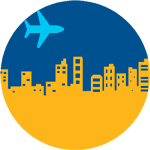Transportation
Cuba has a good land, air and railway infrastructure as a result of which it is possible to go anywhere in the country in a matter of hours. As in other cases, transportation services are available in both currency (very good quality) and those paid for in Cuban pesos. As a rule, tourists resort to transportation services priced in convertible Cuban pesos.
Air: Recommended when travelling from one end of the country to the other or to the surrounding keys which can not be accessed by land, such as Cayo Largo del Sur. All the leading tourist resorts and main cities in the country are situated close to the airport, where air taxi service to practically all parts of the country is available.
Maritime: There is a ferry service for transporting passengers to the Isle of Youth and also speed boats.
Bus: This is the means of transportation most extensively used. There are several lines although the most recommended is Via Azul located on Calle 26, Nuevo Veda do, which connects all tourist resorts with the capital. E quipped with comfortable, air-conditioned vehicles and reasonable prices quoted in convertible currency. The other line, Astro, is the leading inter-provincial transportation line in Cuba and offers services to both national passengers and tourists. It is more economical and located at the National bus terminal near Revolution Square.
Motor Vehicles: There are several car rental companies in Cuba: Rex, Cubacar, Vía, Micar, Palco Car and Gran Car, with agencies in each of the leading tourist resorts in the country. With the exception of some of the keys, for example Cayo Largo del Sur, los Jardines de la Reina and Cayo Levisa, the rest of the resorts can be accessed by land. This is the best way to see the country and meet its people. The network of asphalted highways and roads in Cuba is both comprehensive and in acceptable technical conditions and connect the mayor resorts with the Havana.
However, caution should be exercised when driving along the rural thoroughfares especially with cyclists and horse-drawn vehicles, at times without lights, and domestic animals (mainly cows and horses) which may eventually wonder into the roads and highways. Vehicles can be rented with or without a driver.
Taxis: There is excellent taxi service in each of the tourist resorts and leading cities in t he country. Several companies operate throughout the national territory: Panataxi, TaxiOK, Phoenix S.A., among others. Prices vary according to the distance covered and the type of cab.
Trains: Although the country is equipped with an extensive network of railways, trains are outdated and do not respond to European or North American standards. They are also uncomfortable and often lagging behind schedule.
Nevertheless, it is still a good means of transportation when covering long distances. The most recommended is the Havana-Santiago de Cuba Special. Travellers can buy their tickets in convertible Cuban pesos a few hours in advance (one or two days at least) at any of the LADIS offices located inside the train terminal. There is also a line that covers Casablanca-Hershey-Matanzas, the only electrical train line in the country with its own history. The train crosses areas of great scenic beauty and is therefore a good option when travelling Havana-Matanzas or vice versa.
Casablanca is a small town on the margins of Havana Bay which can be accessed either by car or by a ferry that spans across the busy harbour. This is th e shortest route and also a very interesting experience. The so-called Hershey or Casablanca train makes 5 daily trips to Matanzas and back. Only tourists with an adventurous spirit and a lot of patience are advised to use the trains as a means of transportation. In Cuba, the wagons are furnished only with seats and there is no night-couch or restaurants on board.

